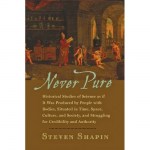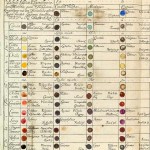history of science
This is what I miss out on by not reading the physical copy of the New York Times: ads! I recently picked up a copy of the Times science section and saw an ad for these wonderful vintage patent office models from the 1900s.
As if they're not steampunky enough, each one comes with a little yellowed, handwritten, calligraphic tag that I'm dying to read because I am convinced it must contain cryptic clues to some sort of awesome Neil Stephenson-style mystery. Right??
Never Pure: Historical Studies of Science as if It Was Produced by People with Bodies, Situated in Time, Space, Culture, and Society, and Struggling for Credibility and Authority: this could be awesome, or very very bad. I can't wait to find out.
A restoration of Megatherium from H.N. Hutchinson's Extinct Monsters.
For over a century and a half dinosaurs have been the unofficial symbols and ambassadors of paleontology, but this was not always so. It was fossil mammals, not dinosaurs, which enthralled the public during the turn of the 19th century, and arguably the most famous was the enormous ground sloth Megatherium. It was more than just a natural curiosity. The bones of the "great beast" represented a world which flourished and disappeared in the not-so-distant past, but, as illustrated by Christine Argot in a review of its…
Voting has closed on the Laser Smackdown poll, with 772 people recording their opinion on the most amazing of the many things that have been done with lasers in the fifty years since the invention of the first working laser (see the Laserfest web site for more on the history and applications of lasers). The candidates in the traditional suspense-building reverse order:
Lunar laser ranging 22 votes
Cat toy/ dog toy/ laser light show 41 votes
Laser guide stars/ adaptive optics 46 votes
Holography 47 votes
Laser eye surgery 53 votes
Optical storage media (CD/DVD/Blu-Ray) 60 votes
Laser…
I feel like I have been run over by a truck. Between blogging, working on my book, fieldwork, pitching freelance articles, and research, I just didn't have the energy to come up with something new today. Instead enjoy this post, written a little more than a year ago, about how the hip of a fossil whale was mistaken for the shoulders of an ancient bird. -- Brian
The right hip of Basilosaurus as seen in Lucas' 1900 description.
If you were a 19th century paleontologist and you wanted a skeleton of the fossil whale Basilosaurus, there was only one place to look; Alabama. Even though fossils…
Fossil fish from the Eocene age Green River Formation in Colorado. From Wikipedia.
I am pretty tired of Richard Dawkins putting down paleontology. In his 2004 tome The Ancestor's Tale, as well as in his latest book The Greatest Show on Earth, Dawkins felt compelled to cast the fossil record as an unnecessary bonus when it comes to demonstrating the reality of evolution. "The evidence for evolution would be entirely secure," he asserts in the latter book, "even if not a single corpse had ever fossilized." While this statement contains a crumb of truth - we have learned much about evolution…
I wonder how much more (and more accurate) detail this guy would get when sober. And how much less most other people would be able to say when sober....
Off the top of your head, how many female paleontologists can you name?
Hopefully, thanks to the recent publication of The Fossil Hunter and Remarkable Creatures, the brilliant 19th century fossil collector Mary Anning should spring to mind, but it seems to me that women are underrepresented in discussions of paleontology. In books, documentaries, news reports, and other popularizations, male authorities (from Georges Cuvier and William Buckland to Bob Bakker and Jack Horner today) take center stage much more often than women, and this is despite the fact that there are (and have been) many…
Something I ran across by accident, while perusing our latest copy of Issues in Science and Technology: currently, the National Academies are sponsoring a Visual Culture and Evolution Online Symposium. It runs through Wednesday. What that means, apparently, is their panelists discuss the intersection of design, art, and culture with evolutionary biology concepts (sexual selection, genetics, adaptation, etc.) at a blog set up for the purpose.
The blog is basic (generic template), and a bit confusing. What seems to be happening is that panelists' ongoing contributions are folded into the posts…
A very cool addition to the NLM "Turning the Pages" virtual library, which I blogged about back in December: the Edwin Smith surgical papyrus. You literally click and drag to unroll the papyrus, and then toggle the annotations on or off. While it doesn't have the pretty pictures that some of their other virtual manuscripts do (like Robert Hooke's Micrographia), it's pretty cool to unroll the world's oldest surviving surgical text, written in Egyptian script circa the 17th century BC.
(Alas, while my first instinct was "This would look so cool on the iPad," the website's in flash. Boo.)
This week at Coney Island, the first ever "Congress for Curious People" brings together historians of science, artists, taxidermists, musicologists, and all manner of. . . curious people. It's part of the larger "Congress of Curious Peoples":
Every spring Coney Island USA convenes The Congress of Curious Peoples, a 10-day gathering of unique individuals at Sideshows by the Seashore and the Coney Island Museum, celebrating Coney Island's subversive and exciting power and exploring its political, artistic, and spectacular possibilities through performances, exhibitions, and films by important…
C.B., circa 1708: "These color circles, from a 1708 edition, are the earliest published examples of Newton-style color circles in an artist's manual."
Moses Harris, 1766: "Mimicking the spread of light from a source, Harris places the pure colors at the center of his circle and the lightest at the outer edge."
Schiffermuller, 1772: "Like many others with the same goals, he assumed that there is a knowable natural order to color, one that would confirm the relationship among all forms of knowledge."
More quotes and images from Sarah Lowengard's e-book The Creation of Color in 18th Century…
The latest edition of the open-access paleontology journal Palaeontologia Electronica was recently published, and I am happy to say that it contains my review of The Paleobiological Revolution. If you are interested in the history of science and how paleontology has changed during the past four decades, definitely check it out.
With any luck, I will be able to publish a few more contributions to the technical literature this year. I have one paper in press, another which is presently inching through the review process, a piece I just started writing up about an enormous example of…
Megarachne, (changed to Mesothelae for broadcast) restored as an enormous spider in the series Before the Dinosaurs: Walking With Monsters.
Imagine that you are are standing in a massive junkyard with the remains of cars strewn all about you. A few are relatively complete, but most of the heap is made up of bits and pieces of models from the entire history of automotive innovation. If you were to reach down and pick up one of the scraps, would you be able to tell the make and model of the car it came from?
The challenges a paleontologist faces in reconstructing the life of the past are…
From Richard Waller, "A Catalogue of Simple and Mixt Colours with a Specimen of Each Colour Prefixt Its Properties"
Philosophical Transactions of the Royal Society of London, vol. 6, 1686/1687 (London, 1688)
Noting the lack of a standard for colors in natural philosophy, and inspired by a similar table published in Stockholm, Richard Waller indicated that his "Table of Physiological Colors Both Mixt and Simple" would permit unambiguous descriptions of the colors of natural bodies. To describe a plant, for example, one could compare it to the chart and use the names found there to identify…
Cordyceps in glass, by glass artist Wesley Fleming -- a strange depiction of a rather horrid business. For more, do go to the source, the lovely Myrmecos Blog, which is all about bugs.
Now, the best of the week's gleanings. I'm going to categorize them from here out, and at least try to keep them from being from completely all over everywhere about everything.
Mind, brain, and body (including those gene things)
While reading Wolpert's review of Greenberg's book about depression (he didn't much like it), I found that the Guardian has a particularly rich trove of writings and resources on…
--A great NYT article on science museums and cabinets of curiosities:
This antic miscellany is dizzying. But there are lineaments of sustained conflict in the apparent chaos. Over the last two generations, the science museum has become a place where politics, history and sociology often crowd out physics and the hard sciences. There are museums that believe their mission is to inspire political action, and others that seek to inspire nascent scientists; there are even fundamental disagreements on how humanity itself is to be regarded. The experimentation may be a sign of the science museum's…
During the 1920's, poisons could be found in abundance in almost any New York apartment. Cyanide, arsenic, lead, carbon monoxide, radium, mercury, methyl alcohol and more; these materials were part of everyday life, especially bootlegged alcohol in the "dry" era when the only stiff drinks commonly available had to be distilled from more dangerous liquids. Accidental poisonings were not uncommon, but with the availability of so many lethal substances it was easy for some to use them for their own nefarious purposes. What might seem to be an accident might truly be murder, and, as Deborah Blum…
This may appeal to some of you:
The 15th biannual conference of the European Association of Museums for the History of Medical Sciences (EAMHMS) will be held at the University of Copenhagen, 16-18 September, 2010. This year's conference focuses on the challenge to museums posed by contemporary developments in medical science and technology.The image of medicine that emerges from most museum galleries and exhibitions is still dominated by pre-modern and modern understandings of an anatomical and physiological body, and by the diagnostic and therapeutical methods and instruments used to…
Cyanides are old poisons, with a uniquely long, dark history, probably because they grow so bountifully around us.
They flavor the leaves of the yew tree, flowers of the cherry laurel, the kernels of peach and apricot pits, the fat pale crunch of bitter almonds. They ooze in secretions of insects like millipedes, weave a toxic thread through cyanobacteria, mass in the floating blue-green algae along the edges of the murkier ponds and lakes, live in plants threaded through forests and fields.
But cyanide didn't really become a widely used poison until the 18th century, beginning with some…




